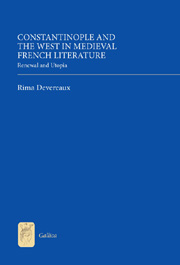Book contents
- Frontmatter
- Contents
- List of illustrations
- Dedication
- Acknowledgements
- List of abbreviations
- Note to the reader
- Introduction
- Part I Renewal and Utopia: The Terms of the Debate
- 1 Making Sense of History: East–West Relations and the Idea of the City in the Twelfth and Thirteenth Centuries
- 2 Renewal and Utopia: Two Paradigms for Understanding East–West Relations in Medieval French Texts
- Part II Constantinople Desired
- Part III The Renovatio of the West
- Conclusion
- Appendix 1 Original Latin Quotations
- Appendix 2 References to Constantinople in Other Epics and Romances
- Appendix 3 Outline of Events in the History of East–West Relations from the Second Crusade to the Palaeologan Reconquest
- Bibliography
- Index
- Already Published
1 - Making Sense of History: East–West Relations and the Idea of the City in the Twelfth and Thirteenth Centuries
from Part I - Renewal and Utopia: The Terms of the Debate
Published online by Cambridge University Press: 05 February 2013
- Frontmatter
- Contents
- List of illustrations
- Dedication
- Acknowledgements
- List of abbreviations
- Note to the reader
- Introduction
- Part I Renewal and Utopia: The Terms of the Debate
- 1 Making Sense of History: East–West Relations and the Idea of the City in the Twelfth and Thirteenth Centuries
- 2 Renewal and Utopia: Two Paradigms for Understanding East–West Relations in Medieval French Texts
- Part II Constantinople Desired
- Part III The Renovatio of the West
- Conclusion
- Appendix 1 Original Latin Quotations
- Appendix 2 References to Constantinople in Other Epics and Romances
- Appendix 3 Outline of Events in the History of East–West Relations from the Second Crusade to the Palaeologan Reconquest
- Bibliography
- Index
- Already Published
Summary
Together with Chapter 2, this chapter will introduce the methodological and intellectual foundations for the study and set out the debate with which it is concerned, both in general terms and in relation to specific literary texts. Byzantium had particular importance for the West in the twelfth century. As i have said, the concepts of aemulatio and renovatio, and in particular the use of the translatio topos, were significant for the West's attitude to Constantinople and shed light on the relationship between Western renewal and dealings with the Byzantine capital. This notion of renewal had implications for the representation of the city, through the augustinian doctrine of the two cities and the identity of the city as a combination of material structure (urbs) and community (civitas). The nature of the utopia was radically different to this, involving as it did the idea of admiratio and the role of the onlooker in fashioning the city as utopia.
Some aspects of Western interest in Byzantium during the twelfth century
The rise of the Comnenian dynasty in 1081 heralded a period of dramatically increased contact between Byzantium and the West. Such contact was favoured by the establishment of the latin kingdom of Jerusalem, and aided by the matrimonial policies and crusading connections of ruling Western families, such as the house of Blois-Champagne in twelfth-century France. Not just ambassadors and crusaders but merchants, artists, scholars and pilgrims too travelled to Constantinople (κωνσταντινούπολις), either by the sea route, boarding a ship in one of the Mediterranean ports, or by any one of various alternative overland routes.
- Type
- Chapter
- Information
- Constantinople and the West in Medieval French LiteratureRenewal and Utopia, pp. 9 - 35Publisher: Boydell & BrewerPrint publication year: 2012



